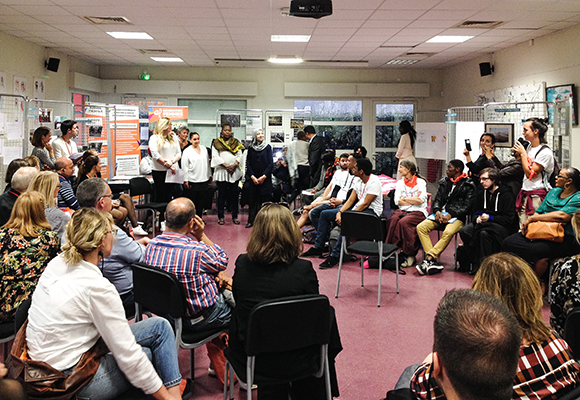
Evry no longer sees itself as a New Town and, with Senart, is reinventing its identity starting from the recognition of a multi-cultural dimension which has been part of the recent history of the New Town. The creation of a new narrative that embraces this multi-cultural diversity represents a challenge – shared by all the other New Towns explored throughout the implementation of this European programme - and requires first and foremost the understanding and value of the role that migrants can play in the contemporary city. The appreciation of their contribution whether it comes through culture and religious forms, associative aggregations or through community commerce and ethnic businesses, is a first milestone. Mostly in contexts where the acquisition of civil rights is often submitted to national legislation and procedures of naturalization which are very complex.
As emphasized in the previous New Towns labs of Milton Keynes and Sabaudia, the pioneering spirit of the New Towns can function as a favourable condition for innovative practices to stand out.
The recognisition that the institutional cultural agenda inadequately represents the society cultural hybridization is a point of departure. Like in Milton Keynes, the young generation takes the lead and the experimental project of the Cultural Ambassadors aims to create a new cultural dimension in GPS while setting the conditions for a permanent cooperation between the educational systems, the schools, the cultural players and the public actors.
Building acceptance and understanding of the city’s migrant communities has to do with establishing a new cultural paradigm capable of reproducing its culturally diverse reality. Prevented from political rights and in the absence of a clear policy framework, migrants take the initiative and mobilize their community around the creation of ethnic shops and cultural and religious centres (often around the station area and in the most deprived neighbourhoods). All this comes with physical modifications of the urban landscape, provoking frictions and/or contributing to isolate the group from the rest of the population.
This not only happens in GPS, but for instance also in Sabaudia (Italy), where the Sikh community from Punjab (India), mostly employed in the agricultural sector, is settled in one of the Sabaudia’s satellite secondary towns located along the coast and where ethnic shops have opened in the neighbourhood only to serve the migrant population. But things can be turned around and GPS could also look at Aarhus (Denmark) where the municipality is committed to transform Gellerup, one of the poorest neighbourhoods in the country – where unemployment rates raise to 50% and 83 different nationalities coexist – into an attractive district. The initial push, guided by the local government, came from a developer who decided to create a Bazar – a commercial space for ethnic goods and products which is revitalizing the neighbourhood, creating local jobs opportunities and playing as a reference place for the immigrant population of the district and bringing flows of customers the entire region.
New Towns are the products of their time and changing social and economic circumstances require adapting to the new circumstances.
Today GPS recognizes the importance of partnering with associations in designing long-term democratic participation and new citizenship paths which can allow migrants to be active players in the socio-economic life of the agglomeration.
The combination of top-down tools (such as citizens’ councils and ad hoc educational programmes in schools) and bottom-up approaches (the actions of migrants’ associations) could be the prerequisite for establishing a renewed government-citizen relation.
Within the framework of the “politique de la ville” national programme, GPS is placing the citizen at the centre of the contemporary urban question. The path undertaken inquires the current citizenship rights and proposes a reflection on the tools and the measures that can be adopted to include migrant populations in the process of redefinition of the contemporary identity of GPS.



